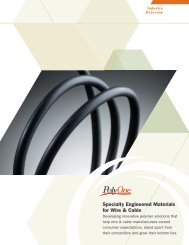Evaluation of Plastisol Inks - PolyOne
Evaluation of Plastisol Inks - PolyOne
Evaluation of Plastisol Inks - PolyOne
Create successful ePaper yourself
Turn your PDF publications into a flip-book with our unique Google optimized e-Paper software.
<strong>Evaluation</strong> <strong>of</strong> <strong>Plastisol</strong> <strong>Inks</strong><br />
Printability or Processing in Screen<br />
Every effort is made to manufacture Wilflex inks to be easily printed under a variety <strong>of</strong> screen-printing conditions. However, quality<br />
printing equipment and processes allow Wilflex inks to perform at their best.<br />
Final Print<br />
In addition to printability in the screen, the finished print must meet specific criteria and should always be evaluated. The evaluation<br />
should be tailored to the type <strong>of</strong> print. For example, the testing procedure for evaluation <strong>of</strong> an athletic uniform print would differ from<br />
that <strong>of</strong> an infant wear print. The tests below are provided for your convenience and cover general print applications only. Please<br />
contact Wilflex Technical Services for additional information.<br />
Wash-Testing <strong>Plastisol</strong>s for Cure<br />
Failure to cure ink properly can result in poor wash-fastness, inferior adhesion, unacceptable durability, and increased likelihood <strong>of</strong><br />
dye migration. Maximum ink tensile strength and elongation are accomplished by ensuring total fusion <strong>of</strong> the ink film. Testing<br />
procedures include wash-testing and testing with solvent, with wash-testing being the more reliable method.<br />
A wash test ensures that printed samples are subjected to standard home-laundering practices to determine state <strong>of</strong> cure on ink<br />
film. Apparatus and materials include:<br />
• Large-capacity, 21.7-gal washer<br />
• Large-capacity, 240-Volt dryer<br />
• Three, large, heavyweight bath towels<br />
Procedure<br />
1. Cut printed sample to be tested in half.<br />
2. Place half <strong>of</strong> the sample in washer with the three large bath towels.<br />
3. Wash settings:<br />
• Medium load, 16.7 gallons<br />
• Hot Wash/Cold Rinse<br />
• Normal /Reg. @ 10 minutes
• 90ml <strong>of</strong> concentrated detergent<br />
4. After washing is complete, place sample and towels into the dryer.<br />
5. Dryer settings:<br />
• Cotton/High (105°F/40°C)<br />
• Timed Dry @ 30 minutes<br />
6. Perform two to five complete wash-and-dry cycles.<br />
7. Compare washed half <strong>of</strong> sample with unwashed portion.<br />
<strong>Evaluation</strong> and Classification<br />
Failure<br />
The ink film is not cured when:<br />
1. Severe cracking <strong>of</strong> the ink is noted.<br />
2. Partial or total loss <strong>of</strong> the ink film from the garment.<br />
Pass<br />
The ink is cured if neither <strong>of</strong> the above is seen. Slight loss <strong>of</strong> color intensity (AATCC Gray Scale for evaluating change in color 4-5)<br />
and slight nap show-through are normal for cured ink films after washing.<br />
Solvent Cure Test<br />
Solvent-testing is the second most-reliable method for testing plastisol cure. The most-reliable method is wash-testing. Solventtesting<br />
is only for plastisol inks that cure at 320°F. If solvent-testing is chosen to evaluate cure, follow these steps:<br />
Method #1:<br />
1. Apply two or three drops <strong>of</strong> 99 percent ethyl acetate to the surface <strong>of</strong> the ink layer being tested. Warning! Ethyl acetate is<br />
poisonous and flammable. Always wear butyl or nitrile (not latex) rubber gloves and goggles when handling this chemical. Do not<br />
pour directly from the container onto the fabric. Use a glass eyedropper.<br />
2. Fold the T-shirt so that the area <strong>of</strong> the ink film that has been treated with the solvent is pressed against an unprinted area <strong>of</strong> the<br />
T-shirt.<br />
3. Firmly press the two layers <strong>of</strong> fabric together with a small C-clamp or similar clamping device for two minutes. If any ink transfers<br />
from the printed area to the unprinted area, it is an indication that the ink film is not completely cured.<br />
Method #1 may give false positive results (the test indicates that the ink is completely cured but it is not) if the ink layer is extremely<br />
thick. If the ink layer is thick, use Method #2 when testing with solvent.<br />
Method #2: Use for Thick Ink Film<br />
1. Apply two or three drops <strong>of</strong> solvent to the fabric on the inside <strong>of</strong> the T-shirt, behind a printed area.<br />
2. Fold the shirt so that you can press the ink layer that has been treated with the solvent against an unprinted area <strong>of</strong> the shirt.<br />
3. Firmly press the two layers <strong>of</strong> fabric together with a small C-clamp or similar clamping device for two minutes. If any ink transfers<br />
from the printed area to the unprinted area, the ink film may not be completely cured.<br />
The ethyl acetate test is described in more detail in "The Solvent Test for Cure" in the April 1995 issue <strong>of</strong> Screenplay . This article is<br />
available as a reprint through ST Publications Inc.<br />
Bleed Test<br />
Since dye-lot variation is very common, it is imperative to test a garment's propensity for dye migration. Historically, fabrics
containing polyester are more likely to bleed than any other fabrics, whereas nylon and cotton are much less likely to bleed.<br />
However, it is suggested that all dark fabrics that will be printed with white or light-colored inks should be evaluated for bleeding.<br />
The bleeding phenomenon occurs due to a reaction between the ink and the dyes <strong>of</strong> the fabric. Two tests for fabric only are<br />
described in "Troubleshooting Dye Migration on Polyester Fabrics," which appeared in Screenplay , March 1995.<br />
The following is a test method evaluating the bleed potential <strong>of</strong> ink printed on a given fabric:<br />
1. Bleed resistance (or the resistance <strong>of</strong> an ink to accept the dyes from polyester fabric) is determined by the chemistry <strong>of</strong> the ink,<br />
complete ink cure, and by the ink deposit. Choose the screen mesh that duplicates the planned use <strong>of</strong> the white ink as well as two<br />
other possible combinations.<br />
2. Print just the white ink on appropriate fabric swatches and hold for three weeks. After three weeks, visually evaluate the prints for<br />
whiteness. (You may choose to try accelerating this evaluation by holding the prints at 105°F/ 40°C for 2 to 5 days.)<br />
"Troubleshooting Dye Migration on Polyester Fabrics" is available as a reprint through ST Publications Inc.; 513-421-2050.<br />
Additional information on synthetic polyester dye migration and sublimation is detailed in the Screen Printing and Graphic Imaging<br />
Association (SGIA) Technical Guidebook.<br />
Fabric Discoloration Test<br />
It is extremely important to pretest on light-colored or stone-washed garments. Avoid stacking hot, because such colors are more<br />
prone to color distortion due to the dye stuffs inherent in the garment. Fabric and dye characteristics can exhibit variance between<br />
manufacturers and from dye lot to dye lot. The following test will determine if the fabric dyestuffs are prone to discolor:<br />
1. Print ink onto suspect fabric and fuse.<br />
2. Cover the print area with a piece <strong>of</strong> the suspect fabric (sandwiching the print) and set in a heat press.<br />
3. Set the heat press to 200°F and 5 psi.<br />
4. Close the transfer press and let sit for four hours before visual evaluation.<br />
If material is prone to discoloration, you will see a "ghost" image <strong>of</strong> your printed image on the material that was covering the printed<br />
area. Please contact Wilflex Technical Services for more information on this phenomenon.<br />
Transfer Release Test<br />
It is important to conduct accelerated age tests in your plant, which will indicate how a transfer will release from the transfer paper<br />
after six months to one year "on the shelf." Accelerated aging tests can be performed by placing the printed transfer in a hot box or<br />
hot room for 100 hours at a temperature <strong>of</strong> 120°F. This will simulate one year <strong>of</strong> shelf life. Tests conducted in your plant will help<br />
keep your transfer/garment reject risk to a minimum.<br />
<strong>PolyOne</strong> © Corporation<br />
<strong>PolyOne</strong> © Corporation<br />
The information contained herein is believed to be reliable, but no representations, guarantees, or warranties <strong>of</strong> any<br />
kind are made as to its accuracy, suitability for particular applications, or the results to be obtained therefrom. The<br />
information is based on laboratory work with small-scale equipment and does not necessarily indicate end-product<br />
performance. Because <strong>of</strong> the variations in methods, conditions, and equipment used commercially in processing<br />
these materials, no warranties or guarantees are made as to the suitability <strong>of</strong> the products for the application<br />
disclosed. Full-scale testing and end-product performance are the responsibility <strong>of</strong> the user. <strong>PolyOne</strong> shall not be<br />
liable for and the customer assumes all risk and liability <strong>of</strong> any use or handling <strong>of</strong> any material beyond <strong>PolyOne</strong>'s<br />
direct control. POLYONE MAKES NO WARRANTIES, EXPRESS OR IMPLIED, INCLUDING, BUT NOT LIMITED TO,<br />
THE IMPLIED WARRANTIES OF MERCHANTABILITY AND FITNESS FOR A PARTICULAR PURPOSE. Nothing<br />
contained herein is to be considered as permission, recommendation, nor as an inducement to practice any<br />
patented invention without permission <strong>of</strong> the patent owner.<br />
Printed in U.S.A.<br />
<strong>PolyOne</strong> Corporation




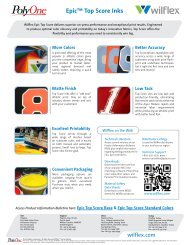
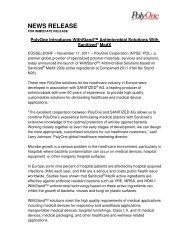

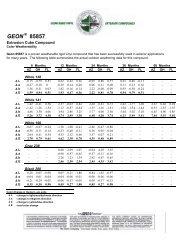
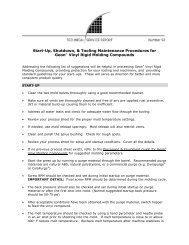
![TPE Injection Molding Guide [PDF] - GLS Thermoplastic Elastomers](https://img.yumpu.com/26329362/1/190x245/tpe-injection-molding-guide-pdf-gls-thermoplastic-elastomers.jpg?quality=85)

